Fencing stairs - gost and types
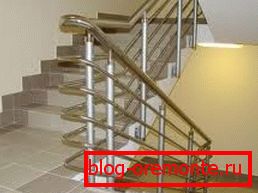
Stainless steel railing for the mid-flight ladder
Railings for stairs are called vertical structures with an average height in the region of one meter (at the level of a person’s belt) having, first of all, a protective function that prevents a person from falling.
Also fencing can serve as an excellent addition to the design of the interior or exterior of the building. Materials for such protective and decorative means are also used very different, it can be brick, concrete, wood, as well as black, stainless and non-ferrous metals.
Stair railings
Despite the wishes of the owners and the imagination of the designer about the height of the fences of the stairs, there is a SNiP on the stairs and fences, which must be followed even in the case when you build your own house.
Everything is very simple - these rules and regulations laid the foundation for the safety of your residence in this building. Various methods and devices are used for fastening such fences, depending on the design of the stairs and the material used for this purpose.
State standards

GOST on ladder railing and general technical requirements
- Regulatory documents - GOST for stair railings, established by the Ministry of Internal Affairs of the Russian Federation by the State Fire Service NPB 245-2001. They spelled out the general technical requirements, as well as the timing of tests and how they are produced (determination of loads).
- If we talk about generally accepted rules, we can say that for welded structures there are standards for welds and rail fastening in accordance with GOST 5264, and the stair steps must withstand a vertical load of 1.8 kN (180 kgf). But with pressure on the fence in the horizontal direction, where the balusters, in fact, should go for a break, the railing must withstand a load of 0.54 kN (54 kgf).
- Of course, in a private house hardly anyone will be something meticulous to check, guided by the SNiP on the stair railing, but the rules relating to strength, you can check the above figures. Please note that force majeure in the private sector does not occur less frequently than at work, therefore such rules should not be neglected. Of course, firefighters at the enterprise should arrange inspections every year, but in your house you can check the structural strength at least during assembly, and then - as needed.
Brick railing

Staircase fence made of bricks
- Of course, railings and stair fences are made of brick, rather, have a decorative rather than constructional course, but, nevertheless, this serves as an obstacle at the edge of the stairs. For young children, this is generally the best security measure, as the masonry has a continuous plane.
- Such a structure can most often be found on the front porch of the building, but it is also equipped with a low brick parapet and descents where there are concrete stairs. Of course, laying in such cases is done with a wire ligation (reinforcement) for structural strength.
- Concrete or brick pedestals are installed along the edges of the stairway, which serve as the basis for the partition barrier. As it can be seen in the photo above, such balusters look more like a pedestal or pedestal for a bust.
Concrete railing
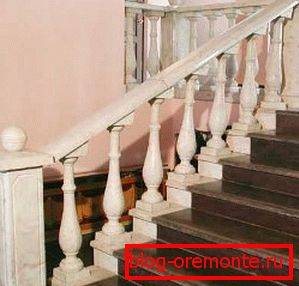
Concrete staircase fence
- Concrete fences have a luxurious look and are mounted mainly on the main structures. Such arrangements look great in large, spacious buildings with high ceilings, while emphasizing the good quality and elegance of the architecture of the building.
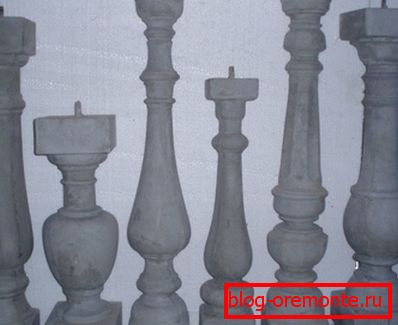
Balusters of various sizes and shapes
- Basically, the visual impression of the appearance of the railing and fences made of concrete is created by balusters, which in turn can be of different sizes and can be given almost any shape. This decorative stand is reinforced on a mandatory basis, but, nevertheless, it is not particularly resistant, therefore a horizontal load of 0.54 kN (54 kgf) will be too heavy for it.
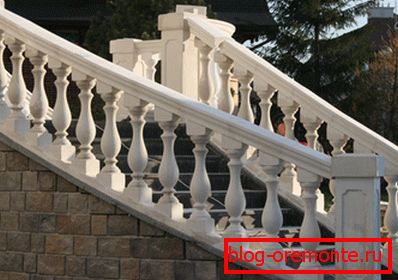
Extreme balusters are made in the form of thumbs for strengthening
- So that the intermediate balusters could withstand the control horizontal load, at the corners of the march, above and below, thicker vertical posts are installed, as can be seen in the photo above. This method of attachment can be applied not only to concrete, but also wooden and even metal fences.
Wooden railing
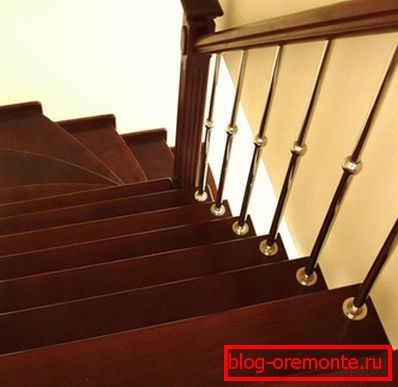
Wooden fence on the wooden stairs
- Wood is always acceptable for the decoration of a building, especially for its interior, besides, any crafts made from such material are antiseptics and many of the wood species have healing properties. Wooden stairs in the house are one of the components of comfort and coziness, they radiate warmth and are pleasing to the eye.

Handrail profiling types
- The profiling of wooden handrails can be the most various and the main, integral condition for them is a rounded smooth surface, the most convenient for the palm.
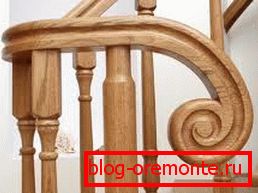
Carved wooden handrails
- Also, the handrails are made in the form of intricate shapes, sometimes even depicting any animals. But such elements are installed not only on wooden, but also on concrete or metal balusters. Wood is also used outside, only in such cases it is desirable to subject it to treatment with antiseptics and paint coatings.
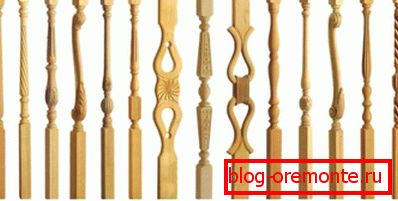
Balusters can be trimmed on your own.
- The shape of the vertical racks for stair railing can vary according to the caprice of the cabinetmaker who grinds them or the designer who designs the stairs.
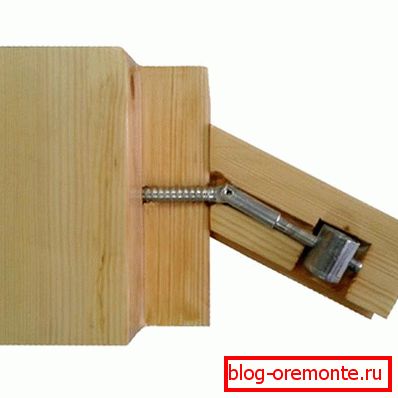
Mounting balusters in the cut
- For mounting balusters on a wooden staircase, various metal ties are used, in the form of the one you see at the top of the figure. This bracket allows you to mount parts at an angle of 90? up to 180?, which is quite enough for stairs.

Corner balusters are thicker than intermediate
- In the same way as all fences, the construction of wood is necessary stability, so the corner or extreme posts make it more powerful. The most important factor for this is the area of the end of the element to be installed - the wider the heel, the more stable the baluster. But for greater rigidity, in addition to the coupling brackets, wooden glue is also used, which fixes the parts together.
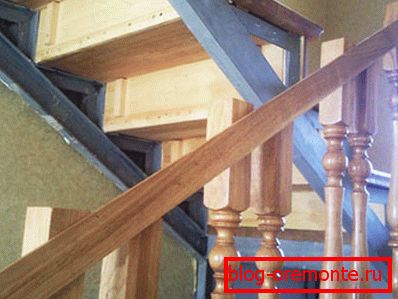
Marking racks for handrails
Council In order for the handrails to lie on the racks correctly, the latter should be cut at the same angle, strictly parallel to the slope of the stairs or kosour. To make the cut the same, you can mark each span with a flat batten, attaching it with scotch tape or simply beating the line with a choline (paint cord).
Metal fencing
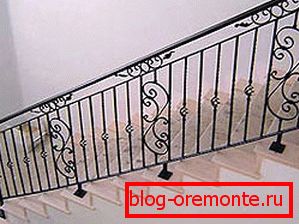
Painted metal railings
- At the moment we are talking about fences from black, galvanized and stainless steel. Perhaps with the addition of brass and / or aluminum parts. Such structures are easiest to do with your own hands, especially for marching and ridge stairs, where the line of the handrail is constantly straight, without a spiral and smooth bends.
- In cases where fences are mounted on the stairs no kosoura, then they, in fact, are the fastening element or the basis of the design. That is, the steps are attached directly to the balusters, and those, in turn, are connected by a handrail and can be fixed to the wall or to the supports on the floor.
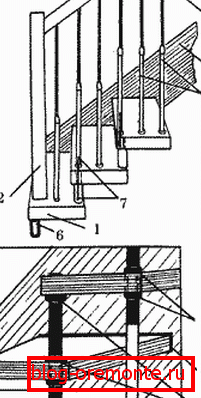
Staircases mounted on rails
- The bottom step is attached to the bowstring and baluster;
- Vertical stand;
- Peril stand;
- Railing;
- Tent;
- Anchor bolt;
- Threaded connections at the top and bottom of the stage;
- Groove in the string for the step.
- For mounting the construction, the string is fastened to the wall, and the opposite, cantilever part of the steps is fixed with the help of guard posts. The connection is made so that the front edge of the upper step rests on the rear edge of the lower one through the stand, and the stands themselves are connected by a handrail.
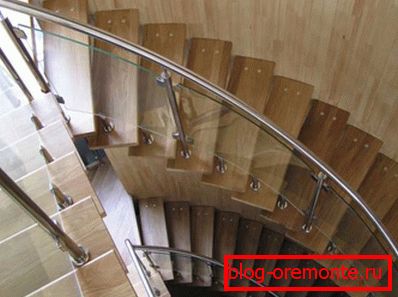
Stainless steel railing on the bezkosurnoy ladder
- Interestingly, such an elegant and fragile at first glance construction, as a bezkosurnaya ladder, in some versions can withstand a load of up to 1800 kg one step! So, without any doubt and hesitation, you can order such an arrangement for your home.
Council It is best of all to make beskosourny ladders to order because at factory assembly they pass all tests put by state standards. And in order to mount such a structure at home, an instruction is attached to it from the factory.
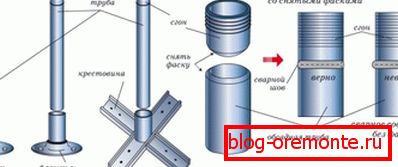
Fastening metal balusters to the steps
- For ladders with kosour use the usual method of mounting racks, using flanges or conventional welding. But at the same time, the latter method implies the presence of a welding seam, which does not look good if it is done outside.
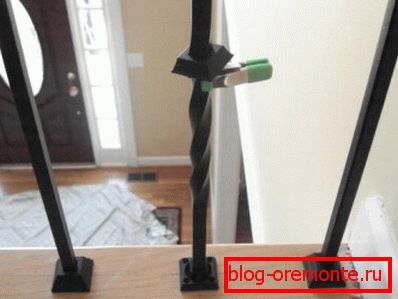
Flange mounting on laminated surface
- Flanges Be sure to use in cases where the baluster is attached directly to the surface (to the platform or step) - this serves as an excellent decoration. In addition, the flange creates an additional area for support and reduces slacking.
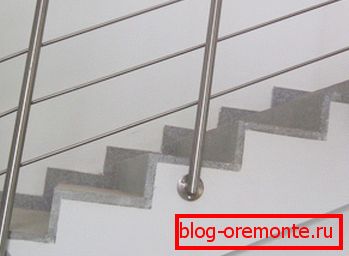
Balusters filled with concrete
Council For fastening fences to concrete stairs, the racks are poured with concrete and additionally welded to the kosour. The same mounting principle remains for metal ladders.
Forged fencing

Wrought iron railing
- Wrought railings are usually mounted on metal or concrete stairs with a cross-member. The principle of fastening such fences is identical to metal, that is, the most basic is the installation of balusters. You can always order a forging in the forge workshops or buy ready-made fragments of grates.
Conclusion
Fences differ not only in type of material and in strength, their price is also ambiguous, which depends primarily on the quality of products. But, in any case, the stairs in the house or on the street must be securely fenced in order to prevent accidents. In the presented video in this article you will find additional information on this topic.